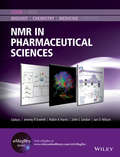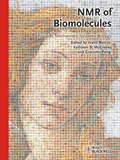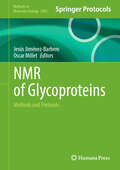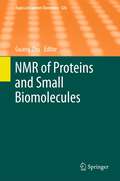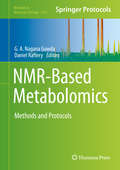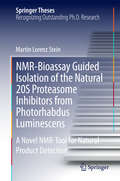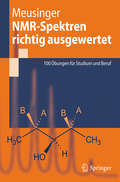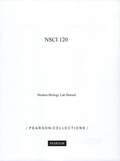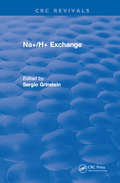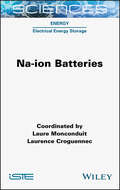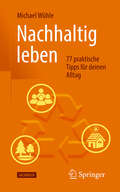- Table View
- List View
NMR in Organometallic Chemistry
by Paul S. PregosinThe ultimate guide for anyone working in transition organometallic chemistry and related fields.This book provides the background and practical guidance on how to efficiently work with routine research problems in NMR. It adopts a problem-solving approach with many examples taken from recent literature to show readers how to interpret the data.Perfect for PhD students, postdocs and other newcomers in organometallic and inorganic chemistry, as well as for organic chemists involved in transition metal catalysis.
NMR in Pharmaceutical Science
by Robin K. Harris John C. Lindon Ian D. Wilson Jeremy R. EverettNMR in Pharmaceutical Sciences is intended to be a comprehensive source of information for the many individuals that utilize MR in studies of relevance to the pharmaceutical sector. The book is intended to educate and inform those who develop and apply MR approaches within the wider pharmaceutical environment, emphasizing the toolbox that is available to spectroscopists and radiologists. This book is structured on the key processes in drug discovery, development and manufacture, but underpinned by an understanding of fundamental NMR principles and the unique contribution that NMR (including MRI) can provide. After an introductory chapter, which constitutes an overview, the content is organised into five sections. The first section is on the basics of NMR theory and relevant experimental methods. The rest follow a sequence based on the chronology of drug discovery and development, firstly 'Idea to Lead' then 'Lead to Drug Candidate', followed by 'Clinical Development', and finally 'Drug Manufacture'. The thirty one chapters cover a vast range of topics from analytical chemistry, including aspects involved in regulatory matters and in the prevention of fraud, to clinical imaging studies. Whilst this comprehensive volume will be essential reading for many scientists based in pharmaceutical and related industries, it should also be of considerable value to a much wider range of academic scientists whose research is related to the various aspects of pharmaceutical R&D; for them it will supply vital understanding of pharmaceutical industrial concerns and the basis of key decision making processes.
NMR of Biomolecules: Towards Mechanistic Systems Biology
by Ivano Bertini Giacomo Parigi Kathleen S. McGreevyNMR is one of the most powerful methods for imaging of biomolecules. This book is the ultimate NMR guide for researchers in the biomedical community and gives not only background and practical tips but also a forward looking view on the future of NMR in systems biology.
NMR of Glycoproteins: Methods and Protocols (Methods in Molecular Biology #2961)
by Jesús Jiménez-Barbero Oscar MilletThis volume explores the latest advancements in the field of Nuclear Magnetic Resonance (NMR) and discusses how new studies provide insight into the structure, conformation, dynamics, and interactions of glycoproteins. The chapters in this book covers topics such as the preparation of isotope-labeled eukaryotic glycoproteins; applications of paramagnetic NMR to dissect glycosaminoglycan-protein interactions; interactions of mucin glycoproteins; applications of NMR to decipher the interactions between viral proteins and the glycans on host cells; NMR methods to identify biomarkers based on the glycoprotein signals directly acquired from intact biofluids; and the applications of MD simulations and other computational methods to characterize the conformation and dynamics of glycoproteins. Written in the highly successful Methods in Molecular Biology series format, chapters include introductions to their respective topics, lists of the necessary materials and reagents, step-by-step, readily reproducible laboratory protocols, and tips on troubleshooting and avoiding known pitfalls.Authoritative and thorough, NMR of Glycoproteins: Methods and Protocols is a valuable resource for both new and experienced researchers who want to learn more about this important and developing field.
NMR of Proteins and Small Biomolecules
by Guang ZhuApplication of NMR and Molecular Docking in Structure-Based Drug Discovery, by Jaime L. Stark and Robert Powers NMR as a Unique Tool in Assessment and Complex Determination of Weak Protein-Protein Interactions, by Olga Vinogradova and Jun Qin The Use of Residual Dipolar Coupling in Studying Proteins by NMR, by Kang Chen und Nico Tjandra NMR Studies of Metalloproteins, by Hongyan Li and Hongzhe Sun Recent Developments in 15N NMR Relaxation Studies that Probe Protein Backbone Dynamics, by Rieko Ishima Contemporary Methods in Structure Determination of Membrane Proteins by Solution NMR, by Tabussom Qureshi and Natalie K. Goto Protein Structure Determination by Solid-State NMR, by Xin Zhao Dynamic Nuclear Polarization: New Methodology and Applications, by Kong Hung Sze, Qinglin Wu, Ho Sum Tse and Guang Zhu
NMR of Quadrupolar Nuclei in Solid Materials
by Roderick E. Wasylishen Stephen Wimperis Sharon E. AshbrookThe content of this volume has been added to eMagRes (formerly Encyclopedia of Magnetic Resonance) - the ultimate online resource for NMR and MRI. Over the past 20 years technical developments in superconducting magnet technology and instrumentation have increased the potential of NMR spectroscopy so that it is now possible to study a wide range of solid materials. In addition, one can probe the nuclear environments of many other additional atoms that possess the property of spin. In particular, it is possible to carry out NMR experiments on isotopes that have nuclear spin greater that ½ (i.e. quadrupolar nuclei). Since more that two-thirds of all NMR active isotopes are quadrupolar nuclei, applications of NMR spectroscopy with quadrupolar nuclei are increasing rapidly.The purpose of this handbook is to provide under a single cover the fundamental principles, techniques and applications of quadrupolar NMR as it pertains to solid materials. Each chapter has been prepared by an expert who has made significant contributions to out understanding and appreciation of the importance of NMR studies of quadrupolar nuclei in solids. The text is divided into three sections: The first provides the reader with the background necessary to appreciate the challenges in acquiring and interpreting NMR spectra of quadrupolar neclei in solids. The second presents cutting-edge techniques and methodology for employing these techniques to investigate quadrupolar nuclei in solids. The final section explores applications of solid-state NMR studies of solids ranging from investigations of dynamics, characterizations of biological samples, organic and inorganic materials, porous materials, glasses, catalysts, semiconductors and high-temperature superconductors.About EMR Handbooks / eMagRes Handbooks The Encyclopedia of Magnetic Resonance (up to 2012) and eMagRes (from 2013 onward) publish a wide range of online articles on all aspects of magnetic resonance in physics, chemistry, biology and medicine. The existence of this large number of articles, written by experts in various fields, is enabling the publication of a series of EMR Handbooks / eMagRes Handbooks on specific areas of NMR and MRI. The chapters of each of these handbooks will comprise a carefully chosen selection of articles from eMagRes. In consultation with the eMagRes Editorial Board, the EMR Handbooks / eMagRes Handbooks are coherently planned in advance by specially-selected Editors, and new articles are written (together with updates of some already existing articles) to give appropriate complete coverage. The handbooks are intended to be of value and interest to research students, postdoctoral fellows and other researchers learning about the scientific area in question and undertaking relevant experiments, whether in academia or industry.Have the content of this Handbook and the complete content of eMagRes at your fingertips! Visit: www.wileyonlinelibrary.com/ref/eMagResView other eMagRes publications here
NMR of Quadrupolar Nuclei in Solid Materials (eMagRes Books #7)
by Roderick E. Wasylishen Stephen Wimperis Sharon E. AshbrookThe content of this volume has been added to eMagRes (formerly Encyclopedia of Magnetic Resonance) - the ultimate online resource for NMR and MRI. Over the past 20 years technical developments in superconducting magnet technology and instrumentation have increased the potential of NMR spectroscopy so that it is now possible to study a wide range of solid materials. In addition, one can probe the nuclear environments of many other additional atoms that possess the property of spin. In particular, it is possible to carry out NMR experiments on isotopes that have nuclear spin greater that ½ (i.e. quadrupolar nuclei). Since more that two-thirds of all NMR active isotopes are quadrupolar nuclei, applications of NMR spectroscopy with quadrupolar nuclei are increasing rapidly. The purpose of this handbook is to provide under a single cover the fundamental principles, techniques and applications of quadrupolar NMR as it pertains to solid materials. Each chapter has been prepared by an expert who has made significant contributions to out understanding and appreciation of the importance of NMR studies of quadrupolar nuclei in solids. The text is divided into three sections: The first provides the reader with the background necessary to appreciate the challenges in acquiring and interpreting NMR spectra of quadrupolar neclei in solids. The second presents cutting-edge techniques and methodology for employing these techniques to investigate quadrupolar nuclei in solids. The final section explores applications of solid-state NMR studies of solids ranging from investigations of dynamics, characterizations of biological samples, organic and inorganic materials, porous materials, glasses, catalysts, semiconductors and high-temperature superconductors. About EMR Handbooks / eMagRes Handbooks The Encyclopedia of Magnetic Resonance (up to 2012) and eMagRes (from 2013 onward) publish a wide range of online articles on all aspects of magnetic resonance in physics, chemistry, biology and medicine. The existence of this large number of articles, written by experts in various fields, is enabling the publication of a series of EMR Handbooks / eMagRes Handbooks on specific areas of NMR and MRI. The chapters of each of these handbooks will comprise a carefully chosen selection of articles from eMagRes. In consultation with the eMagRes Editorial Board, the EMR Handbooks / eMagRes Handbooks are coherently planned in advance by specially-selected Editors, and new articles are written (together with updates of some already existing articles) to give appropriate complete coverage. The handbooks are intended to be of value and interest to research students, postdoctoral fellows and other researchers learning about the scientific area in question and undertaking relevant experiments, whether in academia or industry. Have the content of this Handbook and the complete content of eMagRes at your fingertips! Visit: www.wileyonlinelibrary.com/ref/eMagRes View other eMagRes publications here
NMR-Based Metabolomics: Methods and Protocols (Methods in Molecular Biology #2037)
by Daniel Raftery G. A. Nagana GowdaThis book provides broad coverage of nuclear magnetic resonance (NMR) spectroscopy-based methods and applications for the analysis of metabolites in a wide range of biological samples, from biofluids, cells, animal models, human, to plants and foods. The applications range from mechanistic understanding, biomarker discovery, environmental studies, and drug discovery to nutrition, while NMR methods include global, targeted, and isotope tracer-based techniques. Written for the highly successful Methods in Molecular Biology series, chapters include introductions to their respective topics, lists of the necessary materials and reagents, step-by-step, readily reproducible laboratory protocols, and tips on troubleshooting and avoiding known pitfalls. Authoritative and practical, NMR-Based Metabolomics: Methods and Protocols serves as a wealth of information for beginners as well as advanced practitioners and also as stepping stones for further advances in the field of metabolomics.
NMR-Bioassay Guided Isolation of the Natural 20S Proteasome Inhibitors from Photorhabdus Luminescens
by Martin Lorenz SteinMartin Stein's thesis describes a novel methodology for natural product discovery. Due to its high degree of reproducibility, robustness and sensitivity, the technique can be utilized to detect even trace amounts of bioactive substances in heterogeneous matrices such as fermentation broths or crude organic extracts. This research is thus relevant for a large number of researchers working in natural product discovery. Applications of this novel NMR-based approach include suitable environmental triggers for the induction of biosynthetic machineries. The author demonstrates the extraordinary value of this approach by the successful isolation of two potent inhibitors of the pharmaceutically relevant proteasome core particle from the insect pathogen photorhabdus luminescens. This thesis has led to a number of publications in high-impact journals.
NMR-Spektren richtig ausgewertet
by Reinhard MeusingerDer Band enthält 100 praxisnahe und verständliche Beispiele und Übungen zur korrekten Auswertung von ein- und zweidimensionalen NMR (Nuclear Magnetic Resonance)-Spektren. Alle gängigen Problemstellungen der Spektrenauswertung werden behandelt. Außerdem enthält das Buch eine Liste der wichtigsten Spektrenparameter sowie viele praktische Hinweise. Alle Beispiele und Übungen haben sich in Kursen des Autors bewährt. Sie sind nach verschiedenen Schwierigkeitsgraden ausgewählt und insbesondere auch für das Selbststudium geeignet.
NSCI 120: Modern Biology Lab Manual
by DickeyScientific inquiry is a particular way of answering questions. It can’t be used for all types of questions. The questions that can be answered by science must meet specific guidelines and scientific investigations must be carried out using certain rules. When an investigation is designed properly and meets these guidelines, then the results are acceptable to other scientists and are added to the body of scientific knowledge. If an investigator cannot show that his or her experiment was done according to the guidelines, then the results of that experiment will not be recognized as valid by other scientists.
NY Regents Exam Test Prep Flash Cards: Biology Essentials (Exambusters NY Regents Workbook #2)
by Ace Inc.<P><P><i>Advisory: Bookshare has learned that this book offers only partial accessibility. We have kept it in the collection because it is useful for some of our members. Benetech is actively working on projects to improve accessibility issues such as these.</i><P><P> 450 questions and answers. Essential definitions and concepts.<P><P> Topics: Cells, Biochemistry and Energy, Evolution and Classification, Kingdoms: Bacteria, Fungi, Protista; Kingdom: Plantae, Kingdom: Animalia, Human Locomotion, Human Circulation and Immunology, Human Respiration and Excretion, Human Digestion, Human Nervous System, Human Endocrinology, Reproduction and Development, Genetics, Ecology <P>"Exambusters NY Regents Prep Workbooks" provide comprehensive NY Regents review--one fact at a time--to prepare students to take practice NY Regents tests. Each NY Regents study guide focuses on fundamental concepts and definitions--a basic overview to begin studying for the NY Regents exam. Up to 600 questions and answers, each volume in the NY Regents series is a quick and easy, focused read. Reviewing NY Regents flash cards is the first step toward more confident NY Regents preparation and ultimately, higher NY Regents exam scores!
NY Regents Exam Test Prep Flash Cards: Physics Essentials (Exambusters NY Regents Workbook #4)
by Ace Inc.<P><P><i>Advisory: Bookshare has learned that this book offers only partial accessibility. We have kept it in the collection because it is useful for some of our members. Benetech is actively working on projects to improve accessibility issues such as these.</i><P><P> 600 questions and answers. Essential definitions, formulas, concepts, and sample problems. <P><P>Topics: Measurement, Motion and Forces, Work and Energy, Heat and Gases, Atoms, Fluids, Sound, Light and Optics, DC Circuits, Magnetism, AC Circuits <P>"Exambusters NY Regents Prep Workbooks" provide comprehensive NY Regents review--one fact at a time--to prepare students to take practice NY Regents tests. Each NY Regents study guide focuses on fundamental concepts and definitions--a basic overview to begin studying for the NY Regents exam. Up to 600 questions and answers, each volume in the NY Regents series is a quick and easy, focused read. Reviewing NY Regents flash cards is the first step toward more confident NY Regents preparation and ultimately, higher NY Regents exam scores!
NY Regents Test Prep Flash Cards: Chemistry Essentials (Exambusters NY Regents Workbook #3)
by Regents Exambusters700 questions and answers. Essential definitions, formulas, concepts, and sample problems.<P><P> Topics: Introduction, Matter, Atoms, Formulas, Moles, Reactions, Elements, Periodic Table, Electrons, Chemical Bonds, Heat, Gases, Phase Changes, Solutions, Reaction Rates, Equilibrium, Acids and Bases, Oxidation and Reduction, Introduction to Organic Chemistry, Radioactivity <P>"Exambusters NY Regents Prep Workbooks" provide comprehensive NY Regents review--one fact at a time--to prepare students to take practice NY Regents tests. Each NY Regents study guide focuses on fundamental concepts and definitions--a basic overview to begin studying for the NY Regents exam. Up to 600 questions and answers, each volume in the NY Regents series is a quick and easy, focused read. Reviewing NY Regents flash cards is the first step toward more confident NY Regents preparation and ultimately, higher NY Regents exam scores!
Na+H+ Exchange
by S. GrinsteinPrepared by leading scientists in the field, these volumes compile for the first time, concise, up-to-date reviews of several aspects of the basic properties, distribution, function and regulation of the Na+/H+ antiport. In addition, current methods and the use of inhibitors and ligands for the study of the exchanger are described. These volumes are indispendable to researchers and students in the areas of ion transport, membrane biology and cellular physiology.
Na-ion Batteries
by Laure Monconduit Laurence CroguennecThis book covers both the fundamental and applied aspects of advanced Na-ion batteries (NIB) which have proven to be a potential challenger to Li-ion batteries. Both the chemistry and design of positive and negative electrode materials are examined. In NIB, the electrolyte is also a crucial part of the batteries and the recent research, showing a possible alternative to classical electrolytes – with the development of ionic liquid-based electrolytes – is also explored. Cycling performance in NIB is also strongly associated with the quality of the electrode-electrolyte interface, where electrolyte degradation takes place; thus, Na-ion Batteries details the recent achievements in furthering knowledge of this interface. Finally, as the ultimate goal is commercialization of this new electrical storage technology, the last chapters are dedicated to the industrial point of view, given by two startup companies, who developed two different NIB chemistries for complementary applications and markets.
Nachhaltig leben: 77 praktische Tipps für deinen Alltag
by Michael WühleNachhaltigkeit wird dein Leben bereichern Immer mehr Menschen wollen die Prinzipien der Nachhaltigkeit in ihr Leben integrieren und damit zu einem positiven Wandel unserer Gesellschaft beitragen. Doch wie kann ich meinen Alltag nachhaltiger gestalten? Dieses Buch gibt dir konkrete Tipps dazu und regt dich dazu an, bisherige Lebensweisen zu hinterfragen und womöglich zu verändern. In 77 Themenblöcken zeige ich dir, wie du Nachhaltigkeit ganz einfach in deinen Alltag integrieren kannst. Ob beim Einkaufen, Kochen, Wohnen oder Arbeiten – es gibt unzählige Möglichkeiten, nachhaltig zu leben. Neben vielen Tipps zur praktischen Umsetzung im Alltag liegt ein Fokus auch auf der bewussten persönlichen Auseinandersetzung mit dem Thema Nachhaltigkeit. Mehr Wohlbefinden: Entdecke, wie nachhaltiges Leben zu mehr Gesundheit und Zufriedenheit führt. Achtsames Handeln: Gehe deinen Weg zur Nachhaltigkeit entlang deiner eigenen Werte und Visionen. Teile Wissen: Erforsche die Ideen und Konzepte der Nachhaltigkeit und gib dein Wissen weiter. Übernimm Verantwortung: Trage dazu bei, unsere Welt zu schützen und zukünftigen Generationen eine lebenswerte Welt zu hinterlassen. Das Buch richtet sich an jeden Menschen mit Interesse für das Thema Nachhaltigkeit und wie es im eigenen Leben umgesetzt und gelebt werden kann. Vorkenntnisse sind nicht erforderlich.
Nachhaltig mobil: Wie das Ruhrgebiet die Verkehrswende schaffen kann
by Johannes WeyerDas Buch enthält die Ergebnisse des Projekts InnaMoRuhr, in dessen Rahmen Konzepte nachhaltiger Mobilität erforscht und in mehreren Realexperimenten erprobt wurden. In einem ersten Schritt wurden die Daten einer Befragung sämtlicher Mitglieder der drei Ruhrgebiets-Universitäten Duisburg-Essen, Bochum und Dortmund genutzt, um bestehende Mobilitätsmuster zu identifizieren. Zudem wurden Mobilitätstypen identifiziert, deren Mobilitätsverhalten sich deutlich unterscheidet. Sie reagieren auch unterschiedlich auf Anreize, deren Ziel es ist, sie zu einer Änderung ihres Mobilitätsverhaltens zu bewegen. Die Zukunft der Mobilität stellen sich die meisten Menschen nachhaltig, flexibel und individuell vor. Dabei spielt das Fahrrad eine wichtige Rolle. Auf Basis dieser Daten und unter Rückgriff auf Konzepte der analytischen Soziologie wurde zudem ein Modell des Mobilitätsverhaltens entwickelt, das in der Lage ist, das reale Verhalten mit großer Treffsicherheit zu erklären. Im zweiten Schritt wurden Szenario-Workshops durchgeführt, um mehrere Szenarien zukünftiger Mobilität zu entwickeln, aber auch durch Kontrastierung mit fiktiven Personas auf ihre Alltagstauglichkeit zu testen. Die erfolgversprechendsten Szenarien wurden zudem in Simulationsexperimenten evaluiert und schließlich in drei Realexperimenten mit freiwilligen Probanden erprobt (Schritt 3). Dabei kam eine selbst entwickelte Mobilitäts-App zum Einsatz, die nicht nur Routing-Empfehlungen gab, sondern auch ein – anonymes – Tracking der Versuchsteilnehmer ermöglichte, ergänzt um Feedback-Funktionen, die reichlich genutzt wurden. Das Projekt InnaMoRuhr wurde vom Verkehrsministerium des Landes NRW gefördert und von einem interdisziplinären Konsortium durchgeführt, bestehend aus sechs Instituten der drei UA-Ruhr-Universitäten mit den Schwerpunkten Soziologie, Wirtschaftswissenschaften, Informatik und Energiesystemtechnik. Das Projekt hat gezeigt, dass diese Form der Zusammenarbeit einen großen Mehrwert generiert und zudem Impulse für die praktische Umsetzung von Konzepten nachhaltiger Mobilität geben kann.
Nachhaltige Bewirtschaftung natürlicher Ressourcen: Erfolgsfaktoren in komplexen sozial-ökologischen Systemen
by Ulrich FreyDieses Buch analysiert die wichtigsten Einflussfaktoren für das Management sozial-ökologischer Systeme. An vielen natürlichen Ressourcen betreibt der Mensch Raubbau. Dennoch gibt es Gegenbeispiele nachhaltiger Nutzung von Gemeingütern. Wichtige Fragen wie zum Beispiel: Was zeichnet erfolgreiche Nutzung aus? werden in diesem Buch beantwortet. Anhand von drei der weltweit größten Datensätze zu Fischerei-, Waldbewirtschaftungs- und Bewässerungssystemen werden Erfolgsfaktoren empirisch untersucht und für den Leser einzeln beleuchtet. Das Buch entwickelt über eine Bandbreite von Methoden – Regressionen, Entscheidungswälder und neuronale Netzwerke – prognosestarke und robuste empirisch fundierte Modelle,um ein neues Licht auf bereits häufig untersuchte Faktoren zu werfen, wie zum Beispiel Konfliktlösungsmechanismen. Der Autor stellt 24 Erfolgsfaktoren als Synthese aus seinen Modellen vor, die den ökologischen Erfolg in der Bewirtschaftung natürlicher Ressourcen sehr gut erklären.
Nachhaltige Entwicklung technischer Produkte und Systeme: Der Ingenieurberuf im Wandel
by Jürgen H. FranzDas Buch erläutert ausgehend vom Begriff der Nachhaltigkeit die Anforderungen an die Herstellung technischer Systeme. Es erklärt die Lebensphasen eines Produktes, die Rolle der Nachhaltigkeit in diesen Phasen und die sich daraus ergebenden Konsequenzen für den Ingenieur und die Ingenieurin sowie für die Ausbildung in den ingenieurwissenschaftlichen Studiengängen. Das Buch zeigt, dass durch die Anforderungen, welche die Nachhaltigkeit setzt, der Ingenieurberuf noch vielseitiger und spannender, aber auch verantwortungsvoller wird, als er ohnehin schon ist.
Nachhaltige Gestaltung von lokalen Ernährungssystemen durch Kommunalpolitik und -verwaltung (Stadtforschung aktuell)
by Arnim Wiek David Sipple Heiner SchanzDieses Open Access Buch erarbeitet konkrete Ansatzpunkte, wie die kommunale Praxis in Politik und Verwaltung Beiträge zur Ernährungswende Richtung Nachhaltigkeit leisten kann. Dabei wird u.a. aufgezeigt, dass die Aufgaben von Städten und Gemeinden, beispielsweise bei der öffentlichen Beschaffung, in Planungsfragen oder bei der Wirtschaftsförderung, bereits weit in ernährungsrelevante Bereiche hineinreichen und somit wichtige Hebelpunkte für nachhaltige Praktiken bestehen.
Nachhaltige Konzepte im stationären Handel: Eine Analyse des Ladenbaus (BestMasters)
by Lena StrokaEine unaufhaltsame Bewegung hin zu Nachhaltigkeit kann in den verschiedensten Branchen beobachtet werden. Auch im Bereich des Lebensmitteleinzelhandels (LEH) fordern Kund*innen und staatliche Behörden nachhaltige Maßnahmen ein. Der Wissensstand und die Praxis beziehen sich hierbei in erster Linie auf das Produktsortiment und die Lieferketten des LEHs. Dem Ladenbau, also speziell dem physischen Umfeld des Ladens, wird hingegen wenig Beachtung in diesem Kontext geschenkt. Das vorliegende Buch untersucht, mithilfe welcher Maßnahmen der Ladenbau im Einzelhandel umfassend nachhaltig gestaltet werden kann. Es hinterfragt zudem, welchen Stellenwert die Kommunikation des nachhaltigen Ladenbaus bei Kund*innen einnimmt, um potenzielle Motivationsfaktoren für Einzelhändler*innen und Ladenbauer*innen ableiten zu können.
Nachhaltige Kunststoffverpackungen aus Post Consumer-Rezyklaten: Recyclingfähiges Design, Fertigung und Ökobilanzierung (SDG - Forschung, Konzepte, Lösungsansätze zur Nachhaltigkeit)
by Christian Hopmann Rainer DahlmannDie im Rahmen von EU-Regularien geforderten Rezyklatanteile in Verpackungen stellen Kunststoffverarbeiter aktuell vor Herausforderungen, da sich die Werkstoffeigenschaften von Rezyklaten oftmals von Neuware unterscheiden.Um die Nachhaltigkeit von Kunststoffverpackungen zu verbessern, werden in diesem Bericht interdisziplinäre Forschungsarbeiten vorgestellt, die auf drei Schwerpunkten basieren: Die Untersuchung des erhöhten Rezyklateinsatzes in Verpackungen bei gleichzeitiger Gewährleistung der Recyclingfähigkeit, einem Bewertungsmodell zur Beurteilung der ökologischen Nachhaltigkeit und der Entwicklung eines plattformgestützten Informationssystems für den Austausch relevanter Nachhaltigkeitsdaten. Die Erkenntnisse zu den Einsatzmöglichkeiten von Rezyklaten werden auf ein Demonstratorprodukt übertragen. Das Ergebnis ist eine Mono-PE-Pouch mit Ausgießer mit einem Rezyklatanteil von >60 %.
Nachhaltige Marktwirtschaft: Die Soziale Marktwirtschaft des 21. Jahrhunderts (essentials)
by Wolfgang ViewegWolfgang Vieweg zeigt kompakt und allgemein verständlich, inwiefern die Soziale Marktwirtschaft für die heutige Zeit zu eng geworden ist und weshalb sie unbedingt einer Erweiterung bedarf. In Sachen Nachhaltigkeit hat Deutschland inzwischen eine umfängliche und leistungsfähige Infrastruktur aufgebaut. Nachhaltigkeit ist Chefsache in der Politik, hat einen hohen Stellenwert in den Unternehmen und Menschen ändern ihr Konsumverhalten. Der Autor zeigt, wie die aktuelle Weiterentwicklung von Konzepten und Begrifflichkeiten schließlich in ein neues Bewusstsein mündet und somit die globale Transformation zu einer nachhaltigen Welt befördert.
Nachhaltige Marktwirtschaft: Die Soziale Marktwirtschaft des 21. Jahrhunderts (essentials)
by Wolfgang ViewegWolfgang Vieweg zeigt kompakt und allgemein verständlich, inwiefern die Soziale Marktwirtschaft für die heutige Zeit zu eng geworden ist und weshalb sie unbedingt einer Erweiterung bedarf. In Sachen Nachhaltigkeit hat Deutschland inzwischen eine umfängliche und leistungsfähige Infrastruktur aufgebaut. Nachhaltigkeit ist Chefsache in der Politik, hat einen hohen Stellenwert in den Unternehmen und Menschen ändern ihr Konsumverhalten. Der Autor zeigt, wie die aktuelle Weiterentwicklung von Konzepten und Begrifflichkeiten schließlich in ein neues Bewusstsein mündet und somit die globale Transformation zu einer nachhaltigen Welt befördert.

